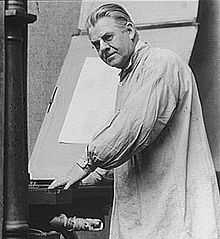Frederic Goudy

Frederic W. Goudy (Bloomington, Illinois, March 8, 1865 – Marlborough-on-Hudson, May 11, 1947) was a prolific American type designer whose typefaces include Copperplate Gothic, Kennerly, and Goudy Old Style.
Biography
Goudy was not always a type designer. "At 40, this short, plump, pinkish, and puckish gentleman kept books for a Chicago Realtor, and considered himself a failure. During the next 36 years, starting almost from scratch at an age when most men are permanently set in their chosen vocations, he cut 113 fonts of type, thereby creating more usable faces than did the seven greatest inventors of type and books, from Gutenberg to Garamond."[1]
Asked how to say his name, he told The Literary Digest "When I was a boy my father spelled our name 'Gowdy' which didn't offer any particular reason for verbal gymnastics. Later learning that the old Scots spelling was 'Goudy,' he changed to that form, while I, for some years, retained the old way. My brother in Chicago still spells with the w. However, I find that occasionally a stranger pronounces the word with ou as long o in go, sometimes as ou in soup, or goo and less frequently with the ou as oo in good. I retain the original pronunciation with ou as in out."[2]
In 1903, Goudy and Will Ransom founded the Village Press in Park Ridge, Illinois. This venture was modeled on the Arts and Crafts movement ideals of William Morris. It was moved to Boston, and then New York. In 1908, he created his first significant typeface for the Lanston Monotype Machine Company: E-38, sometimes known as Goudy Light. However, in that same year the Village Press burned to the ground, destroying all of his equipment and designs. In 1911, Goudy produced his first "hit", Kennerly Old Style, for an H. G. Wells anthology published by Mitchell Kennerly. His most widely used type, Goudy Old Style, was released by the American Type Founders Company in 1915, becoming an instant classic.
From 1920 to 1947, Goudy was art director for Lanston Monotype. Beginning in 1927, Goudy was a vice-president of the Continental Type Founders Association, which distributed many of his faces. By the end of his life, Goudy had designed 122 typefaces and published 59 literary works. His wife, Bertha Goudy (1869–1935), was a compositor of type. The couple had a son, Frederic T. Goudy.
It has been claimed that Goudy was the originator of the well-known statement, "Any man who would letterspace blackletter would shag sheep."[3]
Typefaces

Goudy was the third most prolific type designer in the United States (behind Morris Fuller Benton and R. Hunter Middleton), with ninety faces actually cut and cast, and many more designs completed. His most famous were Copperplate Gothic and Goudy Old Style.
In contrast to his great contemporary Morris Fuller Benton, he is generally best known for his serif designs, with the exception of Copperplate Gothic. Many of his designs are old-style serifs, infused with an interest in the history of printing and calligraphy and an irregularity reminiscent of the Arts and Crafts movement. His sans-serif series, Goudy Sans, adopts an eccentric humanist style with a calligraphic italic, while he also designed display typefaces inspired by medieval manuscripts and blackletter or 'Gothic' writing.[4] His neighbour, Eric Sloane, recalled that he also took inspiration from hand-painted signs.
In 1938 he also designed University of California Old Style, for the sole proprietary use of the University of California Press. The Lanston Monotype Company released a version of this typeface as Californian for wider distribution in 1956, while ITC created a digital version, called ITC Berkeley, in 1983.
Books
- "The Alphabet," Mitchell Kennerley, N.Y.C, 1918.
- "The Trajan Capitals," Oxford University Press, New York, 1936.
- "Typologia," University of California Press, Berkeley, Los Angeles, London, 1940.
References
- Ransom, Will, "The first days of the Village Press: extracts from the diary of Will Ransom," Press of the Woolly Whale, N.Y.C., 1937.
- Bruckner, D.J.R., "Frederic Goudy," Documents of American Design series, Harry N. Abrams, Inc., Publishers, N.Y.C., 1990, ISBN 0-8109-1035-7.
- ↑ Type By Goudy
- ↑ Charles Earle Funk, What's the Name, Please?, Funk & Wagnalls, 1936
- ↑ According to typographer Erik Spiekermann, co-author of "Stop Stealing Sheep" (Typophile.com 15.Oct.2005)
- ↑ My type design philosophy by Martin Majoor
External links
| Library resources about ' |
| By |
|---|
- Britannica Listing
- Goudy, Master of Letters. (Festschrift from 1939)
- Linotype Library Designers: Frederic W. Goudy
- Goudy type designs at Lanston Type Co.
- Frederic Goudy Collection - McLean County Museum of History archives
- Frederic Goudy - Pantagraph (Bloomington, IL newspaper)
- Frederick Goudy at Typophile
- Frederick W. Goudy Collection Archives and Special Collections, Ball State University Libraries (PDF)
- The Frederick W. Goudy Collection From the Rare Book and Special Collections Division at the Library of Congress
|